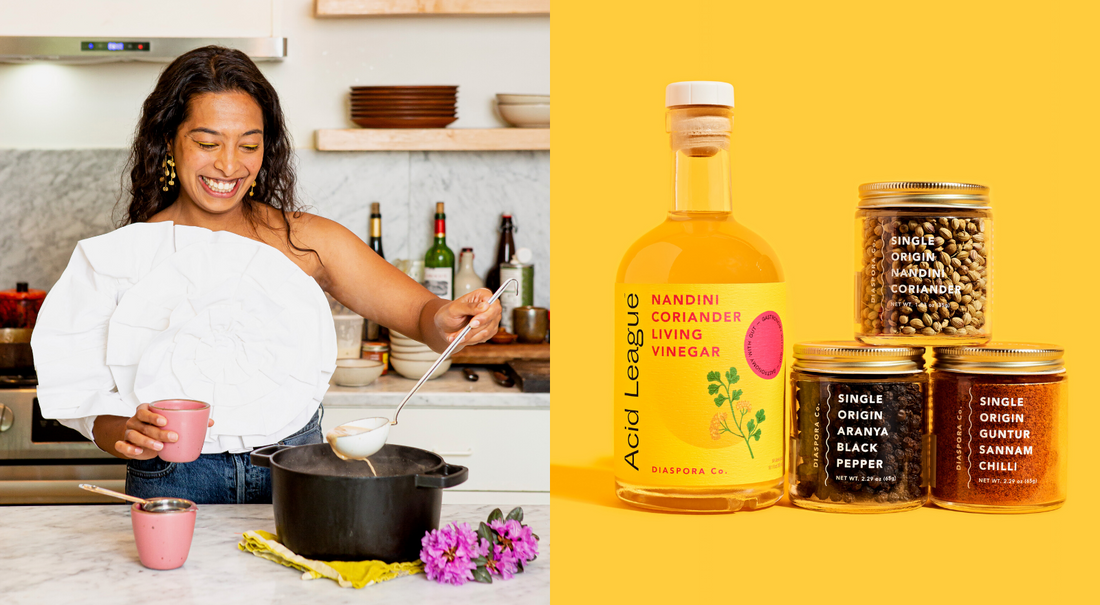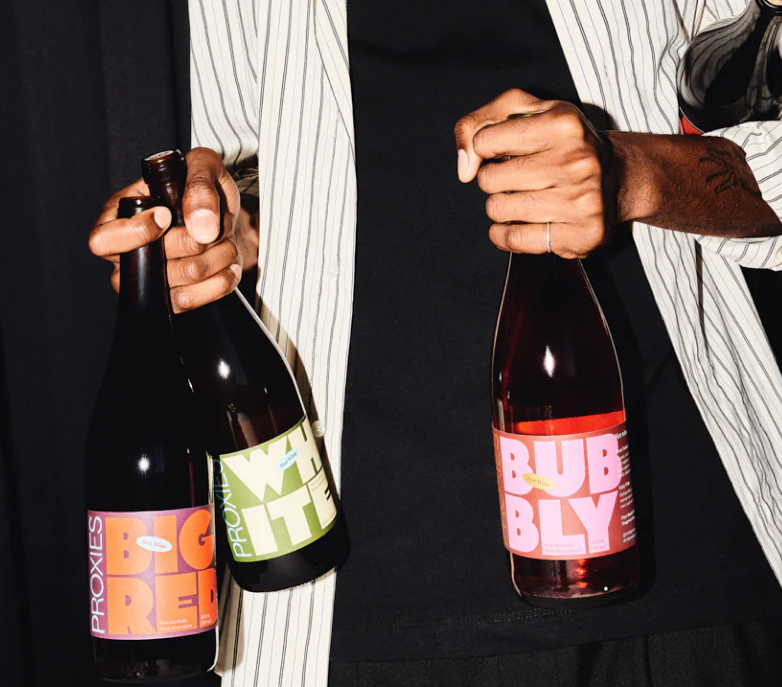
Getting Spicy With Diaspora Co.'s Sana Javeri Kadri
Share
Sana Javeri Kadri’s spice-sourcing philosophy comes down to one major rule: “If it’s not the most delicious thing on the market, we’re not interested.” (We can relate.)
The founder of Diaspora Co. has scoured India to find the country’s finest spice-growers—long-running family farms who grow with regenerative practices and produce for flavor, color and aroma first.
The resulting single-origin spices land in customers’ hands less than a year after harvest for maximum freshness and flavor. That stands in stark contrast to the typical spice trade, where spices are repeatedly blended, shipped, resold, repackaged, and spend plenty of time collecting dust between stages.
Most crucially: Diaspora pays its farmers an average of six times the commodity price for their crops, and grants farmers 30 per cent advances to help them avoid predatory lending. (Over the past two and a half years, they've paid out over $1.5 million to 200 farm partners.)
That effort has paid off: Since launching in 2016, Diaspora has grown from a one-person show to a sizeable team, and their roster of spices has quadrupled from 8 to 35 in just the past year and a half.
With that kind of devotion to flavor, we knew we had to team up and make some culinary magic. The result is our Nandini Coriander Kit, produced in a limited edition of just 600 kits.
The box includes three of Diaspora’s multifaceted spices: Nandini Coriander, Guntur Sannam Chillies and Aranya Black Pepper.
They’re all perfect complements to the aptly-named Nandini Coriander Living Vinegar, which puts Diaspora’s lemony, tropical coriander front and centre. Our culinary team toasted the coriander, brewed it into a vinegar, and combined it with orange juice, ginger and honey for a zesty elixir that adds a dash of sunshine to everything from salad to cocktails.
To ring in the launch of the kit, we sat down with Sana to discuss sourcing spices next door to a tiger reserve, why she used to hate black pepper, and Diaspora's secret-weapon salad dressing.
What was the process of putting the kit together like?
What's so special about our coriander is that it's so lemony. When it's paired with acid, because it’s so lemony, it just, like, sings. That all goes back to the farming technique, where the Sakariya family is actually intercropping the coriander with guavas and lemons. There's like a “what grows together goes together” element there.
There's this salad dressing recipe that Asha (Loupy, recipe developer) worked on for us a while ago—we call it the “roasty toasty salad dressing”. Any like team dinner, I was like, “roasty toasty, please”! It's essentially fennel, cumin, coriander, black pepper, chilis, all roasted and then mixed with vinegar and olive oil and a little bit of sugar. So the idea was, we want to give people all of the spices so that they can take this vinegar and make roasty toasty dressing. (You can find Asha’s Dhana Jeera-Chilli Dressing recipe here!)
Beyond that, any salad dressing, or any use of vinegar, is made better when you add spices. So, why not add it at the infusion stage, versus adding it on later? I think for me it was about figuring out how to use spices in a way that highlights them and makes things sing, rather than letting them just blend in.
The Sakariya family grow the coriander that is included in the vinegar, and the spice is named in tribute to their family farm. Can you tell me a little bit about how you two work together?
I was looking for coriander, and having a pretty hard time. I got samples from all over the country and then I got connected with Dharmesh Sakariya via a regenerative farmer WhatsApp group. I was, like, Command+F-ing coriander to see if anybody was mentioning it. And if they did, I was like, “hiiii!”
I think the farm partners that I click with very quickly have essentially become teachers of regenerative agriculture in their communities, and they're, in a way, evangelizing about it to the people around them. It means that if things get hard, they're not gonna change their minds or backtrack—they're committed to this work for the long haul. Dharmesh was already committed to the fruits on the farm being naturally grown—tree-ripened guava and lemons—so we worked together to really push the envelope on the coriander.
Usually it's dried in the sun, but that leaches the essential oils out of it—so I said, let's shade dry. He developed a system where they harvest all of the stalks and make little bales of coriander, and then they're wrapping those bales in old saris in order for them to shade-dry slowly. That retains color and oil content. And then he's doing a pretty rigorous sorting and seeding process to make sure that you're not getting mostly twigs—you're actually getting a ton of coriander.
Is sun-drying the standard because it’s faster?
And free. A lot of people, when they don't have access to the sun, have to fire-dry—and that uses fuel, so that's expensive. But we're paying a premium to be like, we don't really care how long it takes. We're willing to pay the premium on labor and time. If it's not the most delicious thing on the market, we're not interested.
How about the other spices in the kit?
Guntur Sanam was our third spice that we ever offered, and it's from a chili-growing region: Guntur, Andhra Pradesh. The Narne family have been saving and growing these chilis for generations, and it's a variety that they have seed-saved and kept, so it’s pretty much their variety. In that region, because chili production is the dominant production, most seeds tend to be hybrid GMO seeds that perform well with pesticides and fertilizers—whereas the Narne family has literally been breeding seeds for flavor and color.
They said, “Why not make the powder the way it’s traditionally powdered?” So it’s ground with 10% cold-pressed sesame oil and 10% rock salt, which makes it the most versatile chili. It's not salty enough to be a chili salt at all—the salt just amps up all the flavors. I use it from, like, Italian cuisine to Indian food. It’s a great gochugaru sub in Korean food—when I showed a gochugaru farmer our chili, they couldn't tell the difference. It's a very versatile chili.
The Aranya black pepper is probably, after our chai masala, our bestselling spice. Black pepper can be so shitty, and this kind of blows open what black pepper can be. I hated black pepper until we sourced this one. I was like, “What is this doing for my food beyond a little bit of sharpness?” Now I totally get it, and I'm a big pepper snob now.
The difference is, the Parameswaran family, who grows the Aranya black pepper, has been doing this for 35 years. [Their pepper is] vine-ripened, and you usually see green berries being plucked and dried, because they're easier to handle when they're unripe. You have less waste, and you'll lose less to the birds.
But really, you want to be picking a fully ripe pepper, because the flavors are just like 10x more developed. It's the same reason you would want a tree-ripened peach versus like a peach that ripened in a box in a truck somewhere, right? It's just giving all the sugars and flavor profiles the opportunity to develop. Then it's sun-dried very slowly and hand-threshed. All the processing is really, really gentle.
The Parameswaran family has a very diverse farm—it’s next to a tiger reserve. They have jackfruit, they have rice, they have coffee—but for commercial high-end sale, they only grow pepper. Everything else is just for personal consumption, and to nourish the soil and add biodiversity. And when I've encouraged them to sell the rice or coffee, they're like, “Doing pepper right takes up all our time, so we can't do these other things to the quality standards that we want to sell at”—which is really beautiful. It tells you about their commitment to quality.
As you’ve been working with more and more farmers expanding the company, what kind of impact have your policies had on farmers?
We give harvest advances to everybody. The conventional model involves paying people once the spice has been delivered to the buyer, and that's really the piece that hurts people. How is a farmer supposed to front all of those costs and manage their cash and wait for a bit of payout, all the way at the end? So we're giving farm partners 30% advances on their harvests.
That's the piece that feels most important, because none of our farm partners are reliant on bad debt or predatory lending. That seems like a dramatic statement, but predatory lending is, like, the baseline of working in Indian agriculture. Like, almost every farmer you work with has some kind of loan that has an astronomical interest rate.
We're saying, if you're working with us—especially if we know it's gonna be a long-term partnership—you don't have to do that. We will work with you to come up with lending terms to make it fair. That's really hard for us but, you know, our farmers don't need to know that.
In terms of impact: The first year, the thing I usually see is that our partners get smartphones. They want to have WhatsApp, and they're able to, in real time, send us images and connect to world culture.
Second year, they usually send their kids to a better school, because they can afford it. And then in the third year, they start thinking, “Okay, I clearly have a long-term buyer. How can I start paying my employees better and getting better access to labor, reliable access to labor?”
When your basic needs aren't met, you can't think about how to better pay the people around you. So it takes a while—but it gets there.
This interview has been edited and condensed.







